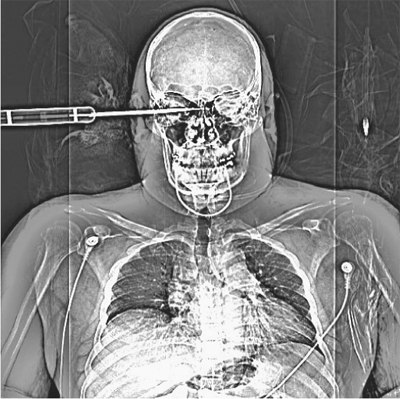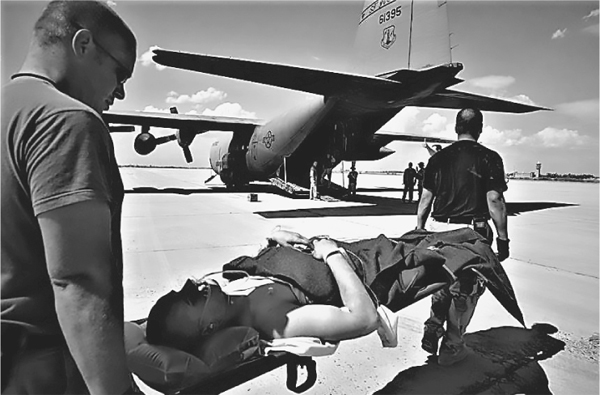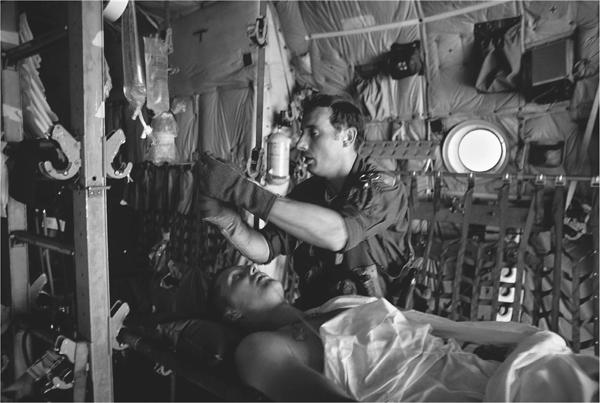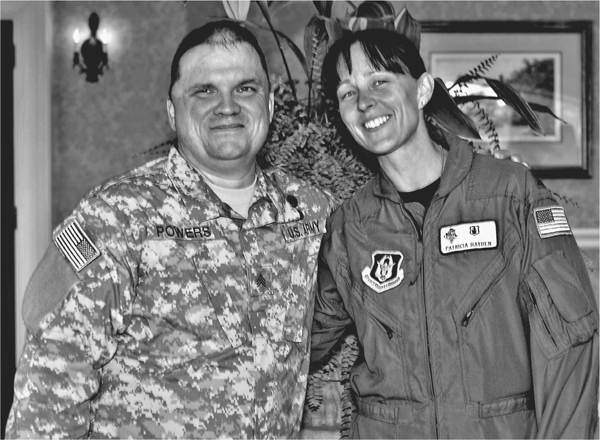“My Head Hurts a Little”
In the summer of 2007, I was on my first deployment to a war zone, Balad Air Base in Iraq. I had joined the Air Force in 2003 and had never been deployed until then; it was also my first assignment as a nurse with a critical care air transport team, CCATT. To be honest, I was scared of entering a war zone and afraid I was not good enough to take care of our nation’s wounded heroes. My respiratory therapist, who deployed with me, was not only an experienced CCATT member; he was also my friend who would be by my side the entire deployment.
My Air Force Reserve unit, the 920th Aeromedical Staging Squadron, was based at Patrick Air Base in Florida. I was part of CCATT at that unit, which was basically a flying intensive care unit. The teams consisted of three highly trained medical personnel: a critical care physician, a critical care nurse, and a critical care respiratory therapist. Our primary job was to fly the critically wounded warriors out of country.
We had flown maybe ten missions out of Iraq when we were given an especially difficult mission. It was midday on July 3, 2007. I was in my PT gear walking around base when my pager went off. I called in to the Aero-medical Evacuation Operations office to see what was up and they said my team, and an aeromedical evacuation (AE) team, was being alerted immediately for an emergency mission. When I asked what it was they simply said to put on my flight suit, grab my go bag, and head on in and the details would be given once we got there. When we got to the trailer, we received our medical briefing. An Army sergeant had been stabbed in the head by an Iraqi insurgent, and we had to fly him directly to the States because of his critical condition. This was only the third time an aero-medical flight had flown from Iraq directly to the States. Normally, the missions flew from downrange into Ramstein Air Base in Germany, and then another team would take them to the States after the patients were further stabilized. But due to his injury the sergeant had to go directly to the States rather than the usual route.
It was not until six months later when I found out the entire story about Sergeant Powers, from the man himself, which I will explain later.
Our critical care team traveled with 750 pounds of medical equipment along with our personal belongings . . . and snacks for the ride, which were often consumed just to occupy our time, or to offset our nervous energy. We gathered everything up, received our intelligence briefing, signed out our weapons, and then headed to the hospital to package our patient for the flight.
Sergeant Powers was still in surgery when we got there, so we got a report from the nurse and the emergency room physician about his condition. He had been stabbed in the head while detaining an Iraqi insurgent. When he was brought in to the ER by his unit via Humvee, he was still awake and talking. At first they wanted us to fly him with the knife still lodged in his head, but after consulting a neurosurgeon back in the States they decided to remove it before flying him out.

He was stabbed in the head by an Iraqi insurgent. CAT scans pinpointed the exact location of the blade and would show any potential damage to the brain.
Technology played a major role in Sergeant Powers’s surgery that day. CAT scans were taken of his brain to find the exact location of the blade and to see if there was any additional damage that could pose issues during the removal process. The CAT scans were emailed to a neurosurgeon at Bethesda Hospital, who was actually driving home from work at the time. The surgeon received a phone call letting him know he would be getting the scans soon and the surgeons downrange, in Iraq, needed his assistance and guidance on how to remove the knife safely. The surgeon pulled over, opened up his laptop, and logged on to his Hotmail account. He opened the scans from his email, reviewed them right there on the side of the road, and instructed the surgeons on how to remove the knife safely.
The procedure was done with only one minor issue and the knife was removed. Initially, the knife was given to me to take back to the States and give to Sergeant Powers’s family. However, after security forces got involved, they took the knife from me and eventually “processed” it and mailed it to Powers a few months later.
Once Powers was out of surgery, we packaged him up for the flight and made our way to the aircraft, a C-17. The flight was going to be approximately fifteen hours, and we were scheduled for two midair refuelings. Since we were going to the States they gave us another patient, a nineteen-year-old soldier who had been shot in the neck during a reconnaissance mission. He was critical as well, and since we had plenty of room we got to take him directly home too. Sergeant Powers and the other soldier were the only two patients on the flight.
The first few hours were uneventful. Both patients were stable, but it was Sergeant Powers I was worried about. He had major surgery to his head. They removed a piece of his skull to compensate for any swelling of the brain that could have occurred. He also had a “bolt” in his head, which was placed so we could measure the pressure in his head (intracranial pressure) during the flight. If this elevated it could pose huge problems for him. His brain could herniate and cause irreparable damage.
Fifteen hours is a long time to be awake, taking care of two critically wounded heroes, and this was after we had already been up for more than ten hours prior to take-off. But we had an amazing team and the aeromedical evacuation crew was the best of the best. They hung in there with us and helped us any way they could to take care of our patients. It was a routine flight, but it was shaping up to be the perfect situation for the perfect, potential storm.

Once he got out of surgery—to remove the knife from his head—he and another soldier were prepped for the flight to Andrews Air Base stateside. Normally critically injured patients in Iraq and Afghanistan would be flown to Ramstein Air Base in Germany, where they would then be transported to nearby Landstuhl Hospital. AIR FORCE PHOTO
Halfway through the flight, we needed to have our first midair refueling. (At the end of the flight, we found out from the flight crew we actually missed our first “stop” for the refueling and we had only refueled once.) During that refueling the plane was bouncing around a lot. I have never felt anything like that before in my life. I was at Sergeant Powers’s side, with the AE nurse holding his litter, trying to prevent it from bouncing up and down. My respiratory therapist was at the other litter, with one of the techs, doing the same. All of us were hanging on just to keep from getting tossed around like rag dolls.
As we were getting bounced and jostled, I noticed Sergeant Powers’s intracranial pressure was rising. Any number less than 20 millimeters of mercury (mmHg) was considered okay (15 or less is optimal), and his was ranging between 15 and 18. As the plane continued to plow through turbulence, during the refueling, his number was climbing . . . 18 . . . 19 . . . 21. I started to think “oh shit.” So first I did manual checks on Powers. I made sure his neck collar was not too tight. Then I made sure his head was midline and I checked his pupils to make sure they were not dilated. (If they were dilated, then we were in big trouble!)
Everything checked out okay, but then his blood pressure and heart rate started going up. The only thing I could do was increase his sedation and hopefully it would relax him a little bit more.
After a quick push of more sedation medication and increasing his hourly rate, Sergeant Powers’s intracranial pressure started to come back to normal after maxing at 25 mmHg. His heart rate and blood pressure came down as well. (Later I found out that Powers was afraid of flying, even though he was a Ranger in the Army and was being trained to be a jumper. After that rollercoaster ride of a flight, I wasn’t a big fan either.)
We finally landed at Andrews Air Force Base the morning of July 4 after more than a fourteen-hour flight. What an amazing feeling it was to be able to transport a couple of wounded warriors home on Independence Day. The ambulance picked us up on the flight line, and we dropped both patients off at Bethesda Hospital in Maryland. We never thought we would see or hear from Sergeant Powers again.
Six months after the historic flight, both teams—the aeromedical evacuation crew and our critical care air transport team—received a call from Air Mobility Command. Since the flight was so historic, with an amazing outcome and the use of a true total force, we were all invited to an annual conference where we would be recognized for the mission. This is where we heard the full story of Sergeant Powers’s injury.
The story began with Sergeant Powers and his unit. They were out performing a reconnaissance mission when they were attacked by Iraqi insurgents. They got the situation under control, and Powers was standing over an insurgent with his rifle aimed down at him while he was detaining him. Without warning the insurgent reached into his boot, pulled out a knife, swung his arm up, and stabbed Sergeant Powers in the right side of his head. Powers did not move. He maintained his position without even realizing what had happened.

During the flight from Iraq to Andrews Air Base, the transport plane encountered turbulence during a midair refueling, and his blood pressure and heart rate increased to dangerous levels. DOD PHOTO
One of his buddies walked up to him and said, “Hey Dan, you know you have a knife sticking out of your head?” At first he didn’t believe him until he looked sideways at his head, and saw something shiny sticking out from just to the periphery of his right eye. One of the other soldiers took over for him and they made him sit down. Powers was talking to them as a Humvee drove him to the hospital at Balad Air Base, Iraq. That is where we came in.
At the conference, they walked all of us on stage, highlighting the use of a total force. First the Army folks from Sergeant Powers’s unit came out. Then it was the Air Force active duty folks from the hospital at Balad.
Next was the aeromedical evacuation crew from the Air National Guard who was on the flight with us. Then our critical care air transport team, which included our active duty Air Force doctor and our respiratory therapist and myself, both of us Air Force Reservists. Next, came the Navy neurosurgeon who had pulled off the road to look at the scans on his computer, and talked the surgeons downrange through the surgery. Then finally, out came Sergeant Powers and his wife, Trudy, which was a total surprise for all of us on stage. We had no idea he was going to be there. We had heard he just had surgery to put a titanium plate in his head and his surgeon would not allow him to come to the conference. But, as miracles can happen, he was able to be there and let me tell you there was not a dry eye in the house as Dan and his wife walked across the stage and gave each and every one of us a hug. What an amazing moment, personally and professionally!
We got to talk to Dan and Trudy for a long time, and that is when we heard the entire story from him and also learned he was afraid of flying. At that point it finally made sense why all of his numbers elevated during the midair refueling and why the additional sedation worked. They still have the knife that was lodged in his head, but Trudy keeps it in a drawer and says she still can’t look at it.
To this day I still keep in touch with Dan and Trudy. I am blessed to have them in my life and to be able to call them my dear friends. That day in Balad, I think possibly God had a plan when my team was alerted for the mission to bring Dan home. It was to bring two wonderful people into my life. Dan is a brave soldier, an amazing husband, and a dear friend. He is still in the Army doing incredible things. Since his injury he has deployed two more times, once to Afghanistan and once to South Korea. He has also become a certified jumper for the Army, though he’s still not very fond of flying. He is a true American hero, a courageous soldier, and someone we should all hope to be like someday. I am still in the Air Force Reserves, performing my duties as a critical care air transport team nurse. Transporting critically wounded warriors home is an extremely rewarding job. I get to bring troops home to their loved ones and give them the chance at recovery, or give the families a chance to say goodbye and maybe have some closure. I truly have the best job in the world!!

Six months after an Iraqi insurgent stabbed him in the head with a knife, Sgt. Dan Powers met Maj. Trish Hayden, one of the critical care air transport team members who cared for him during a fourteen-hour flight. TRISH HAYDEN’S PERSONAL PHOTO
—Maj. Trish Hayden, Critical Care Air Transport
Team Nurse with the Air Force Reserve 920th
Aeromedical Staging Squadron
When wounded warriors are brought in for emergency care, military doctors and nurses realize they’re treating more than just another patient. They’re someone’s son or daughter, a husband or wife, a father or mother. They all have someone back home who cares.